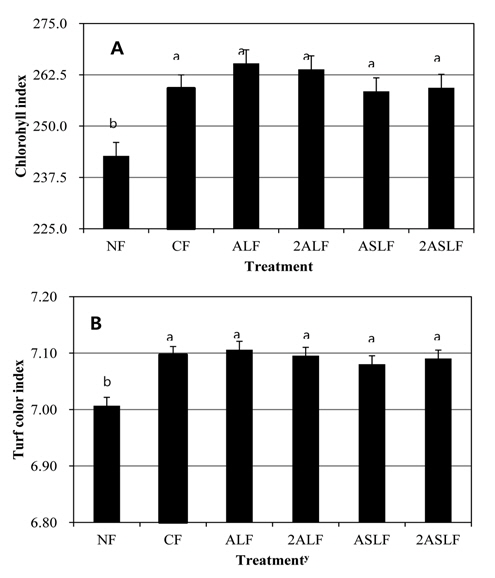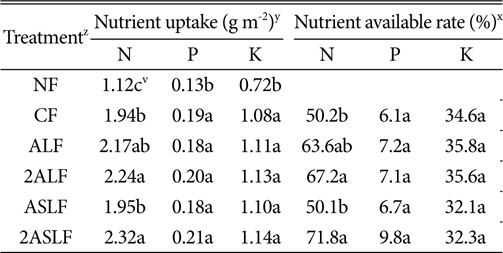



This study was conducted to evaluate the effects of two amino acid fertilizers on the growth of creeping bentgrass and N uptake. Fertilizer treatments were designed as follows; non-fertilizer (NF), control (CF), recommended amount (ALF), double amount (2ALF) of amino acid liquid fertilizer (AaLF), recommended amount (ASLF) and double amount (2ASLF) of amino acid liquid fertilizer contained with saponin (AaSLF). Turf quality of treatments of AaLF and AaSLF such as turf color index, chlorophyll index and root length was similar to the treatment of CF. Dry weight and content, uptake and availability of N were investigated highest in the 2ALF and 2ASLF. These results suggested that foliar application of AaLF and AaSLF was enhanced turf quality and growth of creeping bentgrass by stimulating uptake and availability of N.
삶의 질이 높아지고, 여가활동의 증가와 레저산업의 발달로 골프를 즐기는 인구가 증가하였다. 골프가 대중화되면서 골퍼들의 코스에 대한 눈높이가 증가하여 친환경적으로 관리되는 골프코스와 고품질의 잔디조건이 요구되고 있다. 친환경적인 골프코스관리는 시비효율을 향상시키고, 잔디의 각종 병해충에 대한 저항성을 향상시켜 비료사용량과 농약사용량을 감소시키고, 골프장에서 생산되는 폐기물을 재활용하여 환경오염을 최소화하는 것이다(Nick, 2005). 잔디관리에서 시비효율을 증가시키기 위해서 토양과 수질 환경에 좀 더 적은 영향을 미치면서도 비효 기간이 증가되는 완효성 비료를 시비하고(Chen et al., 2007; Kim et al., 2009a, 2009b), 다양한 기능성 비료를 이용하여 잔디생육과 생육환경을 향상시키기 위한 다양한 노력이 진행되고 있는데(Lim et al., 2011) 천연물질이나 기능성 성분 등을 이용하여 잔디의 병해 방제나 저항성 향상을 위해 노력하고 있다(Kwon et al., 2010).
잔디관리에 이용되는 기능성 비료는 기능성 미생물을 함유하는 비료와 기능성 성분을 포함하는 비료로 구분된다. 유산균이나 효모균 등을 포함하는 미생물 비료를 잔디밭에 사용 시 지하부의 생육을 향상시키고, 양분흡수가 촉진시켜 잔디 생육과 품질이 향상된다(Kim et al., 2008a, 2008b; Kim et al., 2010). 또한 아미노산, 키토산 및 사포닌 등이 첨가된 기능성 비료를 시비하면 잔디 생육과 품질 및 시비효율을 증가시킨다고 보고되고 있다(Chang et al., 2010; Kim et al., 2003; Kim et al., 2012; Yoon et al., 2006). 이러한 기능성 비료는 잔디의 색상과 엽록소 함량을 증가시켜 잔디 품질과 생육을 개선하여 불량 환경에서도 생육하도록 도와준다.
기능성 비료의 성분 중에서 가장 많은 연구가 이뤄진 것은 질소 흡수 및 대사 과정에서 최초로 생성되는 아미노산이다. 아미노산은 처리량에 따라 질산태 질소의 흡수, 아미노산 동화에 관련된 효소들의 활성 및 질소 동화량이 증가하여 식물의 생육에 영향을 주는데(Barneix and Causin, 1996; Liu et al., 2005) 아미노산을 처리하였을 때, 양파(
발효액의 아미노산 함량 및 조성은 원료 종류에 따라 다르게 나타난다. 동물성 원료에는 산성 아미노산이 많고, 식물성 원료에는 염기성 아미노산이 상대적으로 높게 존재한다(Yang et al., 1998). 아미노산 비료를 잔디에 시비하였을 때, 잔디 생육과 잔디 품질을 향상시키고(Kim et al., 2003; Kim et al., 2012), 올리고당과 함께 처리할 경우 봄철 한지형 잔디의 생육과 품질 향상에 효과적이었다고 보고되고 있다(Chang et al., 2010).
또한 최근에는 인삼 가공 과정에서 추출한 사포닌을 식물생장에 이용하고자 하는 연구가 진행되고 있다. 인삼의 주요성분 중 하나인 사포닌은 인삼의 주근보다 세근에 많으며(Kim et al., 1984), 추출방법에 따라 제품 중 사포닌 추출 효율이 다르다(Sohn et al., 1984). 실제 사포닌은 인삼에만 존재하는 것이 아니라 100여 종의 다양한 식용작물에 존재하며(Price et al., 1987), 식물에 포함된 사포닌은 각종 병에 대한 저항성을 증가시켜 병원균의 침입을 막아 식물을 병으로부터 보호하는 식물방어물질(phytoalexin)이라 할 수 있다(Osbourn, 1996; Papadopoulou et al., 1999).
따라서 본 연구는 두 종류의 아미노산 비료(아미노산 비료, 아미노산-사포닌 비료)를 크리핑 벤트그래스에 시비하여 생육과 품질에 미치는 영향을 조사하여 기능성 비료로서의 특성을 평가하기 위해 수행되었다.
본 연구는 2009년 6월부터 10월까지 5개월 동안 인천광역시 소재의 SKY72 골프클럽 증식포장에서 수행하였고, 공시 잔디는 2005년 파종되어 약 4년간 관리된 크리핑 벤트그래스(
공시비료는 잔디용 복합비료(11-5-7, (주)풍농), 아미노산 비료(AaLF; Amino acid liquid fertilizer) 및 아미노산-사포닌 비료(AaSLF; Amino acid + saponin liquid fertilizer) 등이 사용되었다. 아미노산 비료(1-6-3, (주)삼협)는 아미노산 발효액이 약 25% 정도 포함되어 있었고, 아미노산-사포닌 비료(1-1-8, (주)삼협)는 아미노산 발효액 원료와 사포닌 발효액 원료가 각각 20%와 15% 정도 포함되었으며, (주)삼협에서 공여 받아 사용하였고, 각 비료의 성분함량은 Table 1과 같다.
[Table 1.] The nutrient composition of fertilizer used in the study.
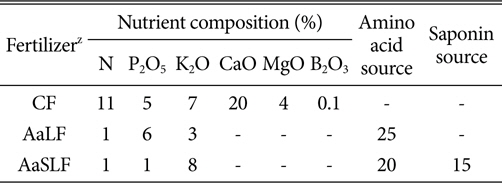
The nutrient composition of fertilizer used in the study.
실험구 단위는 3 m2(1m× 3m) 크기로 전체 실험포장은 54m2였고, 실험구 배치는 난괴법(3반복)으로 배치하였다. 처리구는 비료처리여부에 따라 무처리구(NF), 화학비료를 시비한 대조구(CF), 아미노산 비료(AaLF)를 m2당 1 ml 시비한 정량 처리구(ALF)와 m2당 2 ml를 처리한 배량 처리구(2ALF), 아미노산-사포닌 비료(AaSLF)를 m2당 1 ml 시비한 정량 처리구(ASLF)와 2 ml를 처리한 배량 처리구(2ASLF)였다(Table 2). 아미노산 비료는 1 Lm-2의 처리량으로 수돗물에 희석하여 시험용 분부기(광성분무기)를 이용하여 골고루 시비하였다. 처리구에 따른 시비량은 잔디 생육을 고려하여 복합비료와 기능성 비료의 시비량을 설정하고, 공시비료 중 복합비료는 월 1회, 아미노산 비료와 아미노산-사포닌 비료는 월 2회 실시하였다(Table 2). 복합비료는 잔디 생육이 왕성한 봄, 가을(6월, 9월, 10월)에는 질소 순성 분량으로 2.2 g m-2을 살포하고, 고온다습으로 잔디 생육이 불량한 여름철(7월, 8월)에는 0.12 g m-2을 살포하였다.
[Table 2.] The application method of fertilizer used in this experiment.

The application method of fertilizer used in this experiment.
재배기간 중 잔디깎기는 자주식 그린모어(SIBAURA)로 주 2~3회 5.5 mm 높이로 실시하였고, 통기작업은 봄철에 1회 실시하였으나 시험 기간 동안에는 실시하지 않았고, 배토는 2 mm 두께로 3회 실시하였다. 병해 방제를 위해 테부코나졸 유제와 이프로디온 수화제를 각각 3회와 2회 살포하였다.
잔디 생육 조사는 처리구별 엽색지수, 엽록소지수, 잔디건물중 및 잔디 밀도를 조사하였다. 엽색지수와 엽록소지수는 turf color meter (SOUT, TCM 500, USA)와 chlorophyll meter (SCOUT, CM 1000, USA)을 각각 이용하여 6월 1일부터 7일 간격으로 총 21회 조사하였다. 잔디 생육량 조사는 5.5mm 높이로 설정 된 자주식 그린모어(SIBAURA)에 수거된 예지물을 70 드라이오븐(VS-1203PJ-300, (주)비전과학)에서 24시간 건조시킨 후 건물중을 측정하였고, 월 1회 조사하여 10월까지 총 5회에 걸쳐 조사하였다. 처리별 시비효과에 분석을 위한 잔디 밀도는 시험이 종료된 11월 11일에 처리구별로 잔디 밀도 조사용 코어(1 cm × 1 cm)를 이용하여 잔디 줄기수를 3개 코어씩 조사하였다.
토양의 화학성을 조사하기 위해 시험 전(5/20)과 시험 종료 후(11/11) 총 2회 pH, 전기전도도(electrical conductivity; EC), 유기물 함량(organic matter,O.M), 총질소(total nitrogen, T-N), 유효인산(available phosphate, Av-P2O5), 양이온치환용량(cation exchangeable capacity, CEC), 치환성 양이온 (exchangeable cations, K, Ca, Mg, Na)등을 조사하였고, 분석방법은 토양화학분석법(NIAST, 1998)에 준하였다.
잔디 엽분석은 시험 종료시기인 10월 31일 채취된 잔디 예지물을 건조하여 시료로 사용하였고, 분석항목은 잔디생육에 주요 구성성분인 질소, 인, 칼륨, 칼슘 및 마그네슘 등을 식물체분석법(NIAST, 1998)에 준하여 분석하였다. 양분 흡수 및 이용을 평가하기 위해 건물중과 잔디조직분석 결과를 이용하여 양분 흡수량과 양분 이용율을 조사하였다(Kim et al., 2001).
양분 흡수량(gm-2) =건물중(gm-2) × 잔디 중 양분 함량(%) 양분 이용율(%) = (처리구 양분 흡수량 −무비구 양분 흡수량) /비료 공급량 × 100
통계처리는 SPSS 12.1.1을 이용하여 Duncan 다중검정을 통해 처리구간 유의차를 검정하였다.
시험 전의 토양은 pH 6.98, 유기물 0.63%, 총질소 0.04%, 유효인산 73 mg kg-1 및 치환성 칼륨 0.14 cmolc kg-1로 잔디 생육에는 적합하였다(Ahn et al., 1992). 시험 종료 후 토양의 화학성을 분석한 결과, 모든 처리구의 시험 전보다 pH, 유기물 함량 및 CEC는 증가하였고, 전기전도도, 질소 및 치환성 양이온(K, Ca, Mg, Na)함량은 시험 전과 비슷하였고, 시험 종료 후 처리구별에 토양화학성의 차이는 나타나지 않았다(Table 3). 그러므로 AaLF와 AaSLF의 시비는 토양의 화학적 특성에 큰 영향을 미치지는 않았으나 장기적인 실험을 통해 추가적인 조사가 필요하다고 판단된다.
[Table 3.] Change of soil chemical properties before and after experiment in the study.

Change of soil chemical properties before and after experiment in the study.
잔디의 처리구별 엽색지수와 엽록소지수를 측정한 결과, AaLF와 AaSLF의 엽색지수와 엽록소지수는 각각 7.08~7.11와 258~265로 나타나 무처리구보다는 높았으나 대조구와는 비슷한 결과를 나타내었다(Fig. 1).
NF와 비교할 때, 엽색지수는 CF, ALF, 2ALF, ASLF 및 2ASLF는 1% 증가하였고, 엽록소지수는 6~9% 증가하였다 (Fig. 1). AaLF와 AaSLF의 엽색지수와 엽록소지수는 CF와 비슷하게 조사되었다. 기능성 비료의 시비량과 종류에 따른 엽색지수와 엽록소지수는 배량 처리구(2ALF, 2ASLF)와 아미노산 비료(ALF, 2ALF)처리구에서 약간 높았으나 처리 구간 통계적으로 유의적인 차이는 나타나지 않았다.
처리구별 잔디 밀도는 16.4~22.0개 / cm2로 조사되었고, NF와 비교할 때, CF, ALF, 2ALF, ASLF 및 2ASLF는 각각 29%, 24%, 34%, 19%, 22%씩 증가하였으나 CF와는 비슷한 결과를 보였다(Table 4). 기능성 비료 중에서는 아미노산 비료 처리구에서 약간 높았고, 배량 처리구에서 잔디 밀도가 증가하는 경향을 보였다.
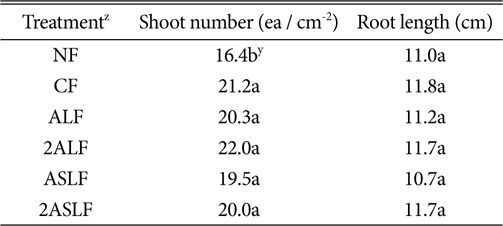
The shoot number of creeping bentgrass as affected by different application of AaLF and AaSLF.
엽색지수, 엽록소지수, 잔디 밀도 및 잔디 뿌리 길이를 통해 기능성 비료의 시비에 따른 잔디 생육과 품질은 무처리보다 증가하였으나 관행 대조구와는 비슷한 결과를 보였다. 일반적으로 아미노산 비료는 엽록소 함량과 뿌리 길이 등이 증가되어 잔디 생육과 품질을 향상시킨다고 보고 되었으나(Kim et al., 2003; Chang et al., 2010) 본 연구에서는 상이한 결과를 보였다. 이는 기능성 비료에 함유된 질소 함량이 선행연구에 비해 약 4~6배 정도 적었기 때문으로 판단된다.
잔디 생육 기간 동안 처리구별 총 예지물량은 46.7~61.7 g m-2로 ALF, 2ALF와 2ASLF에서 가장 높게 나타났다(Table 5). 생육 시기 별 건물중은 7월과 9월에는 적었고, 6월, 8월, 10월에는 높았다. 7월을 제외한 모든 시기에 대조구와 기능성 비료처리구에서 건물중이 높았고, 특히 8월에는 2ALF와 2ASLF처리구에서 대조구보다 높아 기능성 비료는 고온 다습한 여름철에 잔디 생육을 향상시키는 것으로 조사되었다. 잔디 총 건물중은 약간의 차이가 있으나 ALF와 ASLF를 비교할 때, ALF에서 높게 나타났고, Kim et al.(2012)도 사포닌 비료보다는 아미노산 비료를 처리할 때 잔디의 생육과 건물중이 증가한다고 보고하였다. 이는 아미노산은 식물의 질소 흡수와 동화를 촉진하여 잔디의 생육과 품질을 향상시키는 기능성 성분(Kim et al., 2003; Liu et al., 2005)이나 사포닌은 식물의 생장보다는 병해에 대한 저항성을 향상시키는 성분이기 때문으로 판단된다(Osbourn, 1996; Papadopoulou et al., 1999).
[Table 5.] The dry weight of creeping bentgrass as affected by application of AaLF and AaSLF.

The dry weight of creeping bentgrass as affected by application of AaLF and AaSLF.
Kim et al.(2003)은 아미노산 비료의 시비가 크리핑 벤트그래스의 질소 흡수 및 양분이용율이 증가하여 잔디 품질과 생육을 향상시키고, 건물중이 약 12% 정도 증가한다고 보고한 바 있다. Kim et al.(2003)의 연구에 사용된 아미노산 비료는 아미노산 원료가 80% 이상 함유되어 있었으나 본 시험에 사용된 AaLF와 AaSLF에는 약 25%와 20% 씩 포함되어 아미노산 비료에 함유된 아미노산 원료가 상대적으로 적었기 때문에 잔디 건물중의 증가가 적었던 것으로 판단된다(Table 1). Lui et al.(2005)는 아미노산의 처리량이 많을수록 식물의 질소흡수와 동화량이 증가하여 작물 생육이 향상된다고 보고하였다.
시험 종료 후 채취된 예지물을 건조하여 각종 성분을 분석한 결과, 모든 처리구에서 NF보다 높게 조사되었고, CF와 비교할 때, 질소와 칼리는 AaLF와 AaSLF의 처리구에서 높게 나타났다(Table 6). Kim et al.(2003, 2012)은 아미노산 비료 시비 시 잔디의 질소와 칼리 흡수가 증가한다고 보고 하여 본 결과와 일치하는 결과를 나타내었다.
[Table 6.] The nutrient content in the turf plant after experiment. (Unit: %)
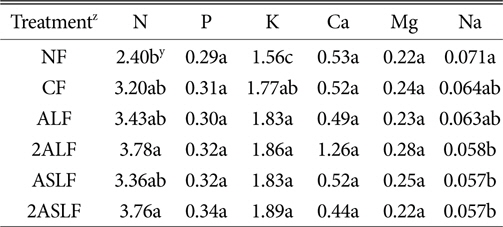
The nutrient content in the turf plant after experiment. (Unit: %)
잔디의 함유 양분과 건물중 및 시비량 등을 통해 시험 기간 중 잔디의 양분 흡수량과 양분 이용율을 평가하였다 (Table 7). 질소, 인 및 칼리의 양분 흡수량은 각각 1.12~2.32 gm-2, 0.13~0.21 gm-2, 0.72~1.14 gm-2 로 나타났고, 기능성 비료 처리구의 모든 항목에서 NF보다 높았다. 기능성 비료 처리구의 인산과 칼리 흡수량은 CF와 비슷한 결과를 보였으나 질소 흡수량은 ALF, 2ALF 및 2ASLF에서 각각 12%, 15%, 20% 씩 높게 나타났다. 양분 이용율은 질소, 인 및 칼리가 각각 50~72%, 6~10%, 32~36%로 조사되었다. 기능성 비료처리구의 인산과 칼리의 양분 이용율은 CF와 비슷하였고, 질소 이용율은 ALF, 2ALF 및 2ASLF에서 각각 27%, 34%, 43% 씩 증가하였다. 이는 아미노산이 질소의 흡수와 질소동화를 촉진하여 식물의 생육과 생산량을 증가시키는 것으로 판단되었으며(Liu et al., 2005), 아미노산 비료 시비 시 질소 흡수를 향상시켜 잔디의 생육과 생산량이 증가하였다(Kim et al., 2003). 아미노산 비료에 비해 사포닌 비료는 잔디의 품질과 생육에 대한 효과가 다소 감소하는 경향을 보였으나(Kim et al., 2012) 아미노산 비료와 혼합된 아미노산-사포닌 비료를 2 ml m-2를 시비하는 경우 질소 이용율이 증가하여 잔디 품질과 생육이 향상되는 것을 알 수 있었다.

The uptake amount and available rate of nutrient in creeping bentgrass by application of AaLF and AaSLF.



